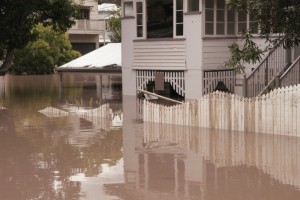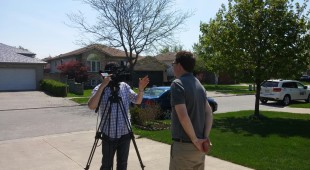Lightning didn’t have to strike once – let alone twice – in Chestermere, AB
0 July 17, 2015 at 3:18 pm by Glenn McGillivray Chestermere, Alberta, located due east of Calgary on the TransCanada, was hit with fairly severe overland flooding and sewer backup as the result of not one, but two, recent heavy rainfall events within days of each other.
Chestermere, Alberta, located due east of Calgary on the TransCanada, was hit with fairly severe overland flooding and sewer backup as the result of not one, but two, recent heavy rainfall events within days of each other.
The first, early morning Sunday, July 12, saw somewhere in the area of 200 millimetres of rain fall in just a few hours. While radar indicated total precipitation of about 225 millimetres, some of that was believed to be hail (which turned out to be small and largely benign) and, thus, was notionally removed from the estimated rainfall total. More than 300 homes were reported to have been damaged by the deluge, with some flooding up to their basement ceilings.
Not two days later, a second rainfall event, on Tuesday, July 14 at around 3:30 pm local time, saw more overland flooding, with around 10 homes reported damaged. It wasn’t immediately clear if any of the ten had been hit by the earlier event.
Problems noted by homeowners in media stories included such things as poor overland flow, exterior below-grade stairwells being inundated, backwater valves that “didn’t work”, over-worked sump pumps, sump pump failure due to loss of power, and loss of valuable items stored on basement floors.
A reading of these media reports (and the comments posted below them) show a clear tendency to blame both the local government and land developers for the damage. This is par for the course for basement flooding, as homeowners will almost always blame third parties, even before engineering analyses are done and cause is determined.
However, action taken by homeowners prior to the flood could have prevented much of the fallout.
Ensuring that the area immediately around a house is properly graded to take water away – not toward – a house lies in the hands of the homeowner, as is ensuring that swales (depressions on properties designed to collect storm water and prevent it from entering homes) are intact and not filled in or built upon.
While it’s, perhaps, true that home builders should elect not to put up homes with below-grade external stairwells, walkouts and reverse-slope driveways, home buyers also play a roll in recognizing the risk these features hold and eschewing homes that include them. If enough people refuse to buy homes with these risky characteristics, they may no longer be offered. (Local governments should also play a role in using bylaws to ban such features, as Toronto and Markham did with their respective bans on reverse slope driveways in new homes.)
Backwater valves, while important for keeping sewage from surcharging into basements, will not prevent surcharge from storm water laterals (unless a backwater valve is installed not just on the sanitary but also on the storm, as is now required in all new builds in Ottawa). In one case, a Chestermere homeowner said his insurer told him to install a backwater valve, but his basement flooded anyway. He expressed the view that his insurer should pay for all of his damages. Yet it appeared that the backwater valve did the job it was intended (and installed) to do – prevent sewage from entering the basement.
On the sump pump side, there is a great deal of information out there on the importance of installing back up sump pumps and back up power for sumps. Barring a statutory requirement for such features, homeowners need to take the time to become familiar with issues related to sump pump failure and take measures to prevent them from occurring.
Finally, several homeowners interviewed said they had lost important family keepsakes and other possessions because they were stored on their basement floors. One professional illustrator lost more than 150 sketchbooks of her work going back a dozen years. She had digitized much of her work, but hadn’t gotten around to scanning the now-lost work. Keeping items off the basement floor is particularly important if basement flooding has been experienced in the past.
Yes, local governments are responsible for storm water management including sewer design and maintenance; and developers are responsible for drainage of subdivisions. But homeowners are fully responsible for what happens – or doesn’t happen – on their own properties. They serve as the last line of defence.
So it’s not a ‘one or the other’ proposition (i.e. either the local government upgrades infrastructure OR the homeowner puts mitigation into place). It has to be ‘one AND the other’.
One Chestermere homeowner unfortunately mused ‘Hey, it’s Mother Nature…If we could predict it, we’d be able to do something about it.”
But one doesn’t need to predict something to prepare for it.
Much of the damage that occurred in Chestermere could have been prevented.
Note: By submitting your comments you acknowledge that insBlogs has the right to reproduce, broadcast and publicize those comments or any part thereof in any manner whatsoever. Please note that due to the volume of e-mails we receive, not all comments will be published and those that are published will not be edited. However, all will be carefully read, considered and appreciated.


Leave a Reply